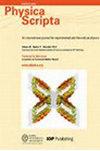Exploring the influence of sudan IV Azo dye on the structural, optical, and dispersion characteristics of PVA/Su-IV composites
IF 2.6
3区 物理与天体物理
Q2 PHYSICS, MULTIDISCIPLINARY
引用次数: 0
Abstract
Flexible polymeric film composites consisting of polyvinyl alcohol (PVA) and Sudan IV azo dye (Su-IV) were synthesized using a casting method. Despite the known optical properties of PVA and azo dyes individually, the combined effects of Su-IV doping in PVA on the material’s optical and nonlinear optical properties have not been thoroughly investigated. This study addresses this gap by exploring the interactions between PVA and Su-IV at various doping concentrations (0.1–0.8 wt%) and their subsequent impact on the material’s structural and optical characteristics. Fourier transform infrared (FTIR) spectroscopy was employed to identify distinct vibrational groups within the composites, revealing that the incorporation of Su-IV induced random deviations in most absorption intensities compared to pristine PVA. Notably, new peaks at 519 and 444 cm−1 emerged, intensifying with increasing Su-IV concentrations, indicating significant interactions between the composite constituents. The optical properties were analyzed through transmittance and reflectance measurements, which uncovered new absorption peaks at 518 and 357 nm in PVA/Su-IV composites. These peaks correspond to electronic energy transitions of 2.4 and 3.6 eV, respectively, and their intensities increased with higher Su-IV content. Additionally, the indirect and direct bandgaps were decreased as Su-IV concentrations increased. The refractive index (n) analysis showed typical dispersion behavior between 850 and 2500 nm, aligning with the Wemple-DiDomenico (WDD) model. Furthermore, the oscillator parameters were calculated. Also, the nonlinear optical susceptibility (χ(3)) was boosted from 4.19 × 10−6 for pure PVA to 3.60 × 10−4 for the sample with 0.8 wt% Su-IV. The nonlinear refractive index (n2) was also measured at 8.55 × 10−2 for the doped sample. These findings demonstrate the potential of PVA/Su-IV composites for applications in nonlinear optics and photonics.探索茚四酮偶氮染料对 PVA/Su-IV 复合材料结构、光学和分散特性的影响
采用浇铸法合成了由聚乙烯醇(PVA)和苏丹Ⅳ偶氮染料(Su-IV)组成的柔性聚合物薄膜复合材料。尽管 PVA 和偶氮染料各自具有已知的光学特性,但 PVA 中掺杂 Su-IV 对材料光学和非线性光学特性的综合影响尚未得到深入研究。本研究通过探索不同掺杂浓度(0.1-0.8 wt%)下 PVA 与 Su-IV 之间的相互作用及其对材料结构和光学特性的影响,弥补了这一空白。傅立叶变换红外(FTIR)光谱法用于识别复合材料中不同的振动基团,结果表明,与原始 PVA 相比,Su-IV 的掺入导致了大多数吸收强度的随机偏差。值得注意的是,在 519 和 444 cm-1 处出现了新的峰值,并随着 Su-IV 浓度的增加而增强,这表明复合材料成分之间存在显著的相互作用。通过透射率和反射率测量分析了光学特性,发现了 PVA/Su-IV 复合材料在 518 和 357 纳米波长处的新吸收峰。这些峰值分别对应于 2.4 和 3.6 eV 的电子能量跃迁,其强度随 Su-IV 含量的增加而增加。此外,间接带隙和直接带隙随着 Su-IV 浓度的增加而减小。折射率(n)分析表明,在 850 纳米到 2500 纳米之间存在典型的色散行为,与 Wemple-DiDomenico (WDD) 模型一致。此外,还计算了振荡器参数。此外,非线性光学感度(χ(3))从纯 PVA 的 4.19 × 10-6 提高到含有 0.8 wt% Su-IV 的样品的 3.60 × 10-4。掺杂样品的非线性折射率(n2)也测得为 8.55 × 10-2。这些发现证明了 PVA/Su-IV 复合材料在非线性光学和光子学领域的应用潜力。
本文章由计算机程序翻译,如有差异,请以英文原文为准。
求助全文
约1分钟内获得全文
求助全文
来源期刊

Physica Scripta
物理-物理:综合
CiteScore
3.70
自引率
3.40%
发文量
782
审稿时长
4.5 months
期刊介绍:
Physica Scripta is an international journal for original research in any branch of experimental and theoretical physics. Articles will be considered in any of the following topics, and interdisciplinary topics involving physics are also welcomed:
-Atomic, molecular and optical physics-
Plasma physics-
Condensed matter physics-
Mathematical physics-
Astrophysics-
High energy physics-
Nuclear physics-
Nonlinear physics.
The journal aims to increase the visibility and accessibility of research to the wider physical sciences community. Articles on topics of broad interest are encouraged and submissions in more specialist fields should endeavour to include reference to the wider context of their research in the introduction.
 求助内容:
求助内容: 应助结果提醒方式:
应助结果提醒方式:


